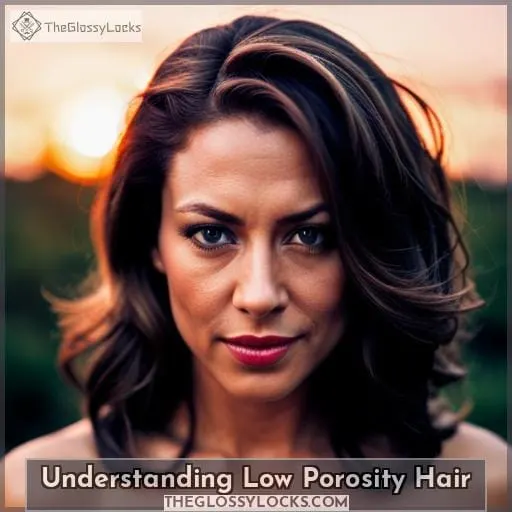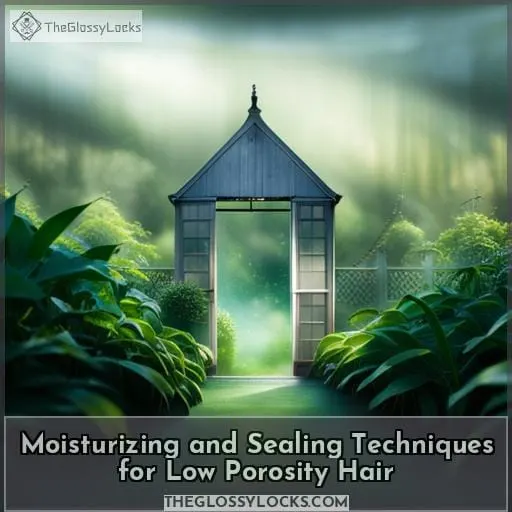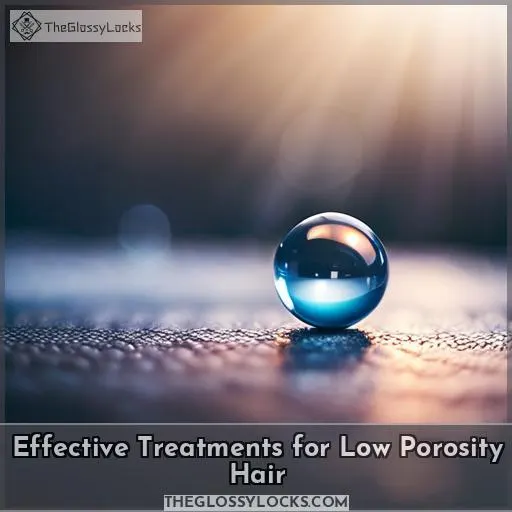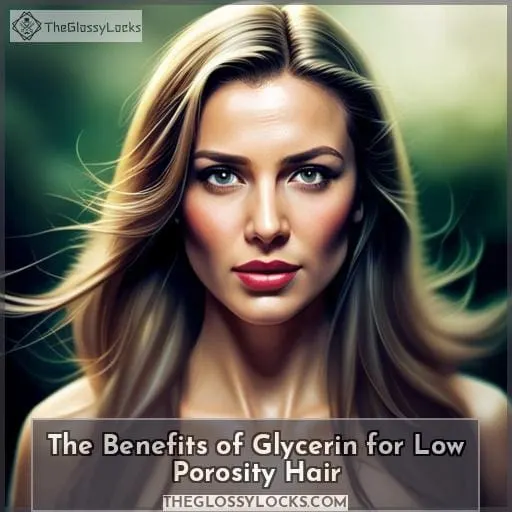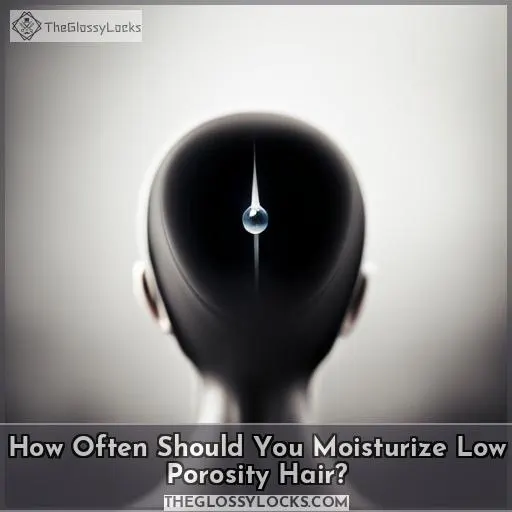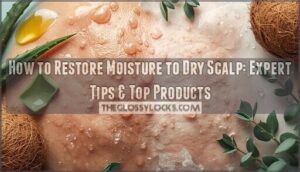This site is supported by our readers. We may earn a commission, at no cost to you, if you purchase through links.
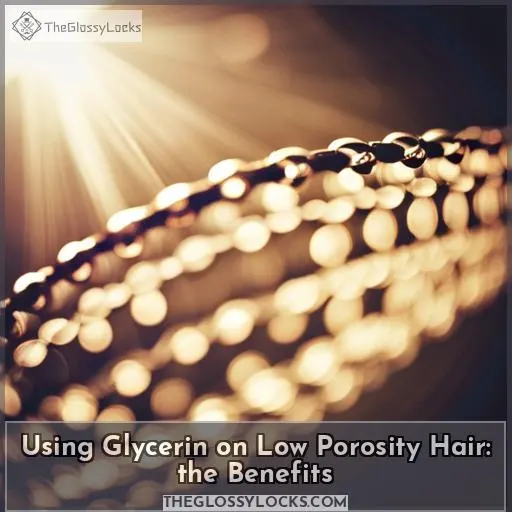 Are you wondering if glycerin can be used on low porosity hair? You’ve come to the right place! In this article, we’ll discuss what makes low porosity hair unique, as well as the benefits of using glycerin on it.
Are you wondering if glycerin can be used on low porosity hair? You’ve come to the right place! In this article, we’ll discuss what makes low porosity hair unique, as well as the benefits of using glycerin on it.
We will also provide a list of alternative ingredients that are beneficial for moisturizing and sealing your strands.
Low porosity hair has flattened cuticles which make it difficult for moisture to penetrate through – but with proper care and maintenance, you can unlock its full potential! Glycerin is an amazing humectant that helps retain and attract moisture into your tresses; however, too much may lead to feeling sticky or greasy, so dilution is key.
With these tips in mind, plus other effective treatments such as pre-pooing or the baggy method, you will soon have healthy-looking locks that everyone would envy!
Table Of Contents
- Key Takeaways
- Can I Use Glycerin on Low Porosity Hair?
- Understanding Low Porosity Hair
- Moisturizing and Sealing Techniques for Low Porosity Hair
- Effective Treatments for Low Porosity Hair
- The Benefits of Glycerin for Low Porosity Hair
- Other Ingredients to Look For
- How Often Should You Moisturize Low Porosity Hair?
- Conclusion
Key Takeaways
- Glycerin attracts moisture, making it beneficial for low porosity hair.
- Dilute glycerin with water or a lightweight conditioner before application.
- Seal with oil or butter after applying glycerin to retain moisture.
- Consider using glycerin alternatives like hyaluronic acid or aloe vera gel.
Can I Use Glycerin on Low Porosity Hair?
If you have low porosity hair, SheaMoisture Manuka Honey Mafura Oil Masque, Majestic Pure Coconut Oil, Goody Shower Cap Hair Accessories, and Hydration Elation Conditioner can be excellent products to use.
These items will provide your hair with intense hydration and nourishment while protecting it from dryness or damage due to the tightly-knit cuticles of low porosity hair.
SheaMoisture Manuka Honey Mafura Oil Masque
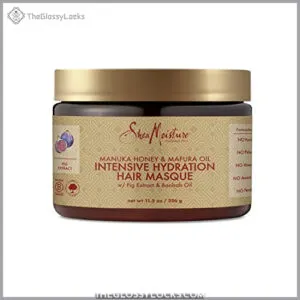
Indulge in the luxuriously nourishing SheaMoisture Manuka Honey Mafura Oil Masque for healthier, shinier, and stronger hair that’s bursting with moisture! This intensive hydration mask is specially formulated with certified organic shea butter, honey, mafura, and baobab oils, as well as antioxidant-rich African Rock Fig, to deeply condition your strands.
Apply generously on clean wet locks from roots to ends, then leave it in for five minutes before rinsing off thoroughly. All of SheaMoisture’s products are ethically traded and sustainably produced without any sulfates, parabens, phthalates, or mineral oil, so you can feel confident about supporting ethical beauty choices while reaping all the benefits of this luxurious masque too.
Enjoy intense hydration that strengthens follicles while smoothing over-processed tresses – perfect for color-treated hair! Plus, its cruelty-free formula means no animal testing was involved either, making this product a guilt-free addition to your haircare routine, whether you have curly or other moisture-needy types of hair.
- Intensely hydrating formula
- Strengthens follicles
- Suitable for different types of curl patterns
- Smoothens over-processed hair
- Cruelty-free formulation
- Not suitable if scalp allergies occur due to some ingredients
Majestic Pure Coconut Oil
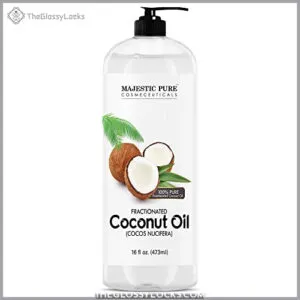
Reap the benefits of Majestic Pure Coconut Oil – a premium quality fractionated coconut oil with no greasy feeling and an extended shelf life – to keep your hair healthy, shiny, and beautiful.
This versatile product is composed mostly of medium chain triglycerides (MCTs) as almost all long chain triglycerides are removed. It is odorless, clear to yellow tinted, and safe for external use only. A patch test is recommended before usage.
Not just limited to skincare applications, but also suitable for toothpaste ingredients, lip balm making, or even in shaving cream form! The best part? It has a very long shelf life, so you can enjoy its many uses without worrying about the expiry date anytime soon!
This natural wonder not only hydrates skin but it’s great on hair too. It provides intense hydration that helps promote stronger locks while eliminating frizz at the same time.
- Composed mainly from MCTs
- Odorless & clear/yellow tinted
- Safe for external use only
- Suitable for multiple cosmetic applications
- Long shelf life & reusable design
- Patch test recommended prior usage
- May cause allergy if not tested properly
- Too much application may lead to clogging pores
Goody Shower Cap Hair Accessories
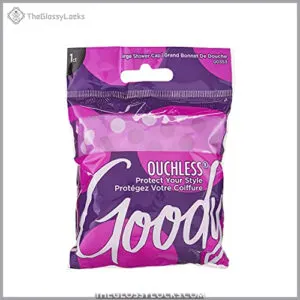
Secure your hairstyle and keep moisture out with the Ouchless design of Goody Shower Cap Hair Accessories. This hair styling essential is designed to fit all volumes of hair and ensure that no steam or moisture escapes, allowing you to maintain your look for longer.
The cap also features a unique ouchless construction, providing comfortable wear while protecting against any potential pain from tightness around the edges.
If you’re looking for an easy way to protect your hairstyle when showering or doing other activities that involve water, then Goody Shower Cap Hair Accessories are ideal for you! Its waterproof design ensures maximum protection, so there’s no need to worry about wetting or damaging delicate strands – especially useful if you have low porosity hair as it struggles with absorbing moisture in general.
With its secure fit and versatile size options, there’s something here for everyone – making sure not one single curl goes unprotected again!
- Secure Fit: Protects Hairstyles by keeping Moisture & Steam Out
- Ouchless Design Provides Comfortable Wear
- Versatile Size Options – Fits All Volumes Of Curls & Waves
- Plastic Material May Cause Sweating After Extended Use
Hydration Elation Conditioner
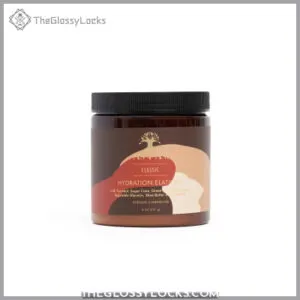
Try Hydration Elation Conditioner and see the difference for yourself—it’s like a breath of fresh air for your curls! This vegan and cruelty-free conditioner infuses Coconut, Sugar Cane, Green Tea extracts, plus Apple, Lemon, Vegetable Glycerin, Shea Butter, and Vitamin E to provide deep moisturization.
Ideal for individuals with curls or waves in need of intense hydration without any animal-derived ingredients. Enjoy increased ease of combing by 60% as well as an improved detangling process by 75%.
Experience luxurious nourishment from this natural hair care product that is free from sulfates, parabens, phthalates, mineral oil, and petrolatum.
- Boosts ease of combing by 60%.
- Enhances the detangling process by 75%.
- Enriched with natural ingredients for effective conditioning.
- Not suitable if you prefer non-natural products/formulations.
- Results may vary depending on an individual’s hair type/condition.
Understanding Low Porosity Hair
Discover how the tightly-knit cuticles of low porosity hair can make it difficult for moisture to penetrate, and learn effective ways to manage this type of hair.
Low porosity is defined by a dense layer of overlapping cuticles that makes it hard for water or product ingredients to enter into the shafts. This creates a natural barrier against moisture, resulting in slow wetting time, increased buildup on strands, and prolonged wash and dry times.
To tackle these challenges, glycerin is an excellent humectant that attracts and retains moisture within locks. Diluting glycerin with water (5-10%) helps balance out potential drying effects in low porosity hair types.
After using glycerin, it’s important to properly seal the hair with nourishing oils or butters to lock in hydration.
In addition to using glycerin, incorporating pre-pooing and clarifying methods can aid in absorption of moisture.
For ultimate results, it’s recommended to incorporate glycerin into your regular hair care routine. This can be done alongside leave-ins, intensive treatments, and the LOC/LCO method. Apple cider vinegar rinses can also be used if necessary, as they are great options for enhancing moisture retention.
By understanding the challenges of low porosity hair and implementing these effective techniques, you can successfully manage and maintain moisture in your hair.
Moisturizing and Sealing Techniques for Low Porosity Hair
If you have low porosity hair, it can be difficult to retain moisture. To help your hair maintain its natural hydration levels, try pre-pooing with an oil or conditioner before shampooing and clarifying regularly to remove product buildup.
Deep conditioning treatments with heat will further enhance the absorption of nutrients into the cuticle, while a lukewarm rinse helps seal in moisture. Afterwards, use a lightweight leave-in conditioner for extra protection against environmental stressors and styling damage.
Try Pre-Pooing
Unlock the potential of your low porosity hair with pre-pooing and experience improved hydration, enhanced strength, and ultimate softness. Pre-Pooing helps open up cuticles to let in moisture, while natural oils provide nourishment for healthier strands.
Heat application during pre-poo can also aid in absorption and help reduce the impact of humidity on hair health.
Combining glycerin with other beneficial ingredients creates an even more effective solution for providing moisture and controlling frizz. This mixture also protects fragile locks from damage or breakage caused by environmental factors like wind or sun exposure.
Try out different combinations of products until you find the one that works best for you!
Clarify Your Hair
Take the time to periodically clarify your hair with a clarifying shampoo, which helps remove product build-up and residue for improved absorption of moisture.
A deep cleansing every couple of weeks is recommended to detoxify the scalp and keep hair from looking weighed down.
Clarifying shampoos are effective in removing buildup that can cause poor texture or frizz on low porosity strands. This allows your glycerin-based products better access into cuticles for optimal moisture retention.
For best results, follow up clarifying washes with an intensive conditioning treatment like pre-pooing or using heat while deep conditioning.
Deep Condition
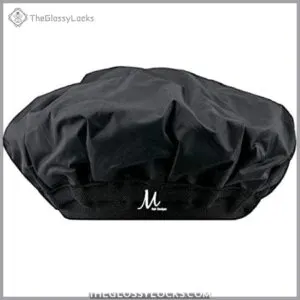
Treat your low porosity hair to a deep conditioning session with a special cap that helps lock in moisture and shine, giving you something to really crow about. The Deep Conditioning Hair Cap is the perfect solution for this. It has both hot and cold application options, providing gentle heat for up to 45 minutes so essential oils can penetrate deeply into your strands.
This hypoallergenic and waterproof material ensures that your hair is safe inside while protecting it from wind or other inclement weather outside. Plus, its easy wash-and-reuse design allows multiple uses of the cap for long-lasting results.
- Hot & Cold Application Options
- Hypoallergenic & Waterproof Material
- Keeps Moisture & Shine Locked In
- Not suitable for all head sizes
- May need additional product application with use
Lukewarm Rinse
After deep conditioning, finish with a lukewarm rinse to seal the cuticles and ensure long-lasting hydration. The temperature of your rinse is key – too hot or cold water can lead to further dryness.
Use detangling methods such as finger combing for curls or using a wide tooth comb for waves that will help distribute product evenly and keep hair from tangling in knots.
Heat treatments are always an option for added moisture retention, but be sure not to overdo it!
Lastly, avoid popular myths like product layering and glycerin overload associated with low porosity hair care routines; these could potentially damage fragile strands more than they benefit them!
With proper knowledge on how best to moisturize low porosity locks comes optimal results; follow the above advice wisely—you won’t regret it!
Use a Leave-in Conditioner
Finish your low porosity hair regimen with a nourishing leave-in conditioner to lock in moisture and keep your strands soft and shiny. Balancing the right amount of glycerin into your conditioning routine can help enhance the benefits of moisturizing while avoiding any myths surrounding its usage on lower porosity hair.
Leave-ins are specifically designed for this purpose. They provide lightweight hydration that won’t weigh down curls or cause product buildup. With curl styling tools like diffusers, they can be easily applied to damp locks before air drying for enhanced definition without sacrificing natural texture.
Glycerin is a great option for adding additional protection. Just remember to dilute it between 5–10% with water first! Ultimately, finding the right balance will provide long-lasting hydration that keeps cuticles closed and prevents frizz from forming.
Effective Treatments for Low Porosity Hair
Are you looking for effective treatments for low porosity hair? From the Greenhouse Effect to using glycerin, LOC/LCO, and an apple cider vinegar rinse, there are many ways to help your hair retain its moisture.
You can start by trying out the Baggy Method – a technique that involves wearing a shower cap or plastic bag over dampened sections of your hair overnight. This helps trap in heat and enhances penetration of oils into the scalp while keeping it hydrated at all times.
Greenhouse Effect
Unlock the power of your locks by utilizing the Greenhouse Effect to increase moisture retention in low porosity hair. Treat your tresses with natural heat treatments like baggy or greenhouse methods, which retain steam and hydrate hair strands from root to tip.
Balance moisture levels with glycerin alternatives such as hyaluronic acid, aloe vera gel, and honey for optimal nourishment.
Get creative; experiment with different humectants and sealing agents tailored to low porosity hair needs! With proper care and attention, you’ll be able to maintain healthy locks that are full of life – all thanks to understanding how to best use the Greenhouse Effect!
Baggy Method
Discover how the Baggy Method can help you revitalize and retain moisture in low porosity hair, unlocking a whole world of manageable locks!
Get ready for overnight hydration that works wonders on your tresses.
Benefits include combating product buildup, reducing wash time, providing alternatives to glycerin such as oil or butter-based sealants, and deep conditioning with heat for cuticle sealing.
Take advantage of this method’s hydrating routine by pre-pooing, clarifying, using leave-ins or intensive treatments, and mixing glycerin with rose water for extra attraction.
Let go of dryness and experience shiny curls free from frizz – all thanks to the Baggy Method!
Add Glycerin
Now add a boost of hydration to your low porosity hair routine with glycerin for an extra moisture-rich treat. Glycerin is effective as a humectant that attracts and holds moisture, creating the perfect balance when used in dilution (5-10%) with water or lightweight leave-in conditioner.
It’s important to also seal after application with nourishing oil or butter to keep cuticles closed overnight and avoid stickiness.
When using glycerin alternative products such as Rose Water plus Panthenol, Shea Butter, Grapeseed Oil, or Aloe Vera are key ingredients too. DIY masks can be created; seek out top-listed ingredients like Vegetable Glycerine while avoiding parabens and petrolatum, etc.
For healthy and manageable low porosity hair, follow these guidelines!
LOC/LCO
Try the LOC/LCO method to effectively lock in moisture and keep your hair healthy – with no need for glycerin.
Pros of LCO include how it can be used on all types of hair, while choosing oils that best suit each type is key.
Styling tips should include applying your chosen oil first before styling product and avoiding too much gel or mousse.
Comparing effects between LOC and LCO will differ depending on the individual’s specific needs from their routine but both are great options for low porosity hair care!
Lastly, incorporate other products such as conditioners to ensure maximum hydration without weighing down locks – so you can say goodbye to dryness forever!
Try an Apple Cider Vinegar Rinse
Adding an apple cider vinegar rinse to your hair care routine can help seal the cuticles of low porosity hair, locking in moisture for a healthy look and feel. The acidic nature of ACV helps restore the pH balance and close off those tightly packed strands, allowing better absorption of other treatments like glycerin or oils.
With regular use, it can even repair existing damage from excessive heat styling or harsh products! When using an ACV rinse on low porosity hair, make sure not to overdo it – once a week is enough! To get optimal results without risking dryness or stiffness afterwards, combine with hydrating conditioners for maximum moisture retention.
Incorporate this simple yet effective treatment into your regimen today for long-lasting locks full of life—no matter what type they may be!
The Benefits of Glycerin for Low Porosity Hair
Glycerin is a humectant that can be used to enhance moisture retention in low porosity hair. For optimal usage, it should be diluted with water or a lightweight leave-in conditioner and sealed after application with an oil or butter for best results.
By incorporating it into your regular routine, you can lock in moisture while smoothing the cuticles of your hair strands.
Glycerin as a humectant
Using glycerin as a humectant, you can lock in moisture and promote healthier locks for low porosity hair. It attracts and holds water molecules to the surface of your strands, helping combat product buildup while allowing deep hydration.
Diluting it with lightweight leave-ins or water ensures optimal use without leaving sticky residue behind due to closed cuticles.
With proper sealing techniques such as LOC/LCO methods after adding glycerin mixtures, you’ll find yourself with soft yet defined curls ready for any occasion.
Dilution for optimal usage
For optimal results, dilute glycerin with water in a 5-10% solution. Used as a humectant, its power to attract and hold moisture is ideal for low porosity hair that has difficulty absorbing it due to tightly knit cuticles.
To maximize the benefits of this natural ingredient, mix it with lightweight leave-in conditioner or water for balance before properly sealing strands with nourishing oil or butter.
Incorporating glycerin into your routine helps lock in hydration while smoothing out frizziness – just avoid leaving it on overnight! Enhance its effects by incorporating pre-pooing and clarifying methods along with deep conditioning treatments and the LOC/LCO method.
Sealing after application
After applying glycerin, seal in the moisture with a nourishing oil or butter for long-lasting locks. To prevent stickiness and enhance moisture retention, avoid overnight use of the product. Combining it with oils such as coconut, olive, or argan can also help to lock in hydration and protect low porosity hair from environmental elements.
Other Ingredients to Look For
When it comes to low porosity hair, there are several key ingredients that you should look for when picking out a product. Panthenol helps soften the hair strands and strengthens them against breakage, while shea butter provides protection from further damage and nourishes your scalp.
Grapeseed oil is a lightweight moisturizer that won’t weigh down your locks, while aloe vera gel or juice acts as an anti-inflammatory and promotes healthy growth of new follicles.
Panthenol
Panthenol is the ultimate secret weapon for infusing your low porosity hair with intense hydration and nourishment. This key ingredient helps to strengthen strands, prevents breakage, and aids in moisture retention.
When using panthenol products on low porosity hair, it’s important to apply a sealant afterwards, such as an oil or butter, so that the benefits are locked in properly.
With regular use of these two powerhouse ingredients within a healthy haircare regime, you’ll soon find yourself rocking lusciously soft tresses full of life!
Shea Butter
Shea Butter helps to soften, strengthen, and protect hair strands, making it an ideal ingredient for low porosity hair. It is a natural emollient rich in vitamins A and E, which can help restore lost moisture.
Shea butter’s high fat content seals the cuticles of your hair so that moisture stays locked in for longer periods of time. Unlike glycerin, Shea butter has fewer chances of causing dryness or product build-up, as it does not draw out humidity from the air like humectants do.
By incorporating this powerhouse ingredient into your routine, you can enjoy long-lasting hydration without worrying about over-drying or frizzing due to excessive moisturizing products being used on the same day!
With its protective benefits against harsh weather conditions too, Shea Butter is a must-have if you are looking to keep your locks healthy and strong at all times!
Grapeseed Oil
Grapeseed oil is packed with Vitamin E and essential fatty acids, making it a great choice for low porosity hair. Its molecules are small enough to penetrate the cuticles up to five times more than other oils.
Glycerin can be used alongside grapeseed oil to better retain moisture within the hair shafts. Its deep conditioning properties help protect against breakage and promote healthy growth.
Grapeseed oil DIY treatments, such as pre-pooing or scalp massages, release tension and smooth out rough patches on the scalp. They also stimulate circulation and increase absorption of nutrients from glycerin applications.
With regular use of both these ingredients combined together, you will significantly enhance your overall hair health.
Aloe Vera Gel or Juice
Aloe Vera’s natural healing properties make it a great choice to soothe and protect low porosity hair, leaving your locks feeling soft and looking shiny. Its benefits include pH compatibility, moisture retention without stickiness, deep conditioning with DIY masks, and anti-inflammatory properties for scalp health.
For effective usage, mix aloe vera gel or juice in place of glycerin with lightweight leave-in conditioner or water for balance, and seal cuticles after application with nourishing oil or butter.
How Often Should You Moisturize Low Porosity Hair?
It’s important to regularly moisturize your curls and waves with a quality product so that you can keep them looking healthy and hydrated. Low porosity hair, in particular, requires extra attention when it comes to maintaining moisture balance since its tightly packed cuticles make it more difficult for the strands to absorb water or any other hydrating ingredients.
For optimal results, try following these steps:
- Establish an effective moisturizing routine that fits into your schedule.
- Make sure you use products with nourishing ingredients like shea butter and glycerin.
- Seal in the moisture by lightly running oil over each strand after application of the product.
- Look for signs such as dryness or buildup between wash days if additional conditioning is needed.
With proper care through regular deep conditioning treatments combined with light oils, natural humectants like glycerin can provide long-lasting hydration without weighing down low porosity hair types.
Conclusion
You’ve now learned the benefits of using glycerin on low porosity hair and the steps that can help you achieve optimal results.
From understanding the basics of low porosity hair, to moisture management tips and key ingredients to look for, to treatments that help lock in moisture – the possibilities are endless.
Pre-pooing and clarifying methods can aid in moisture absorption, and adding glycerin to your routine can help keep your hair moist and smooth.
With the right ingredients and care, you can be sure your locks are healthy and well-maintained. So, make sure to incorporate glycerin into your hair care routine for healthy, beautiful, and long-lasting results.

